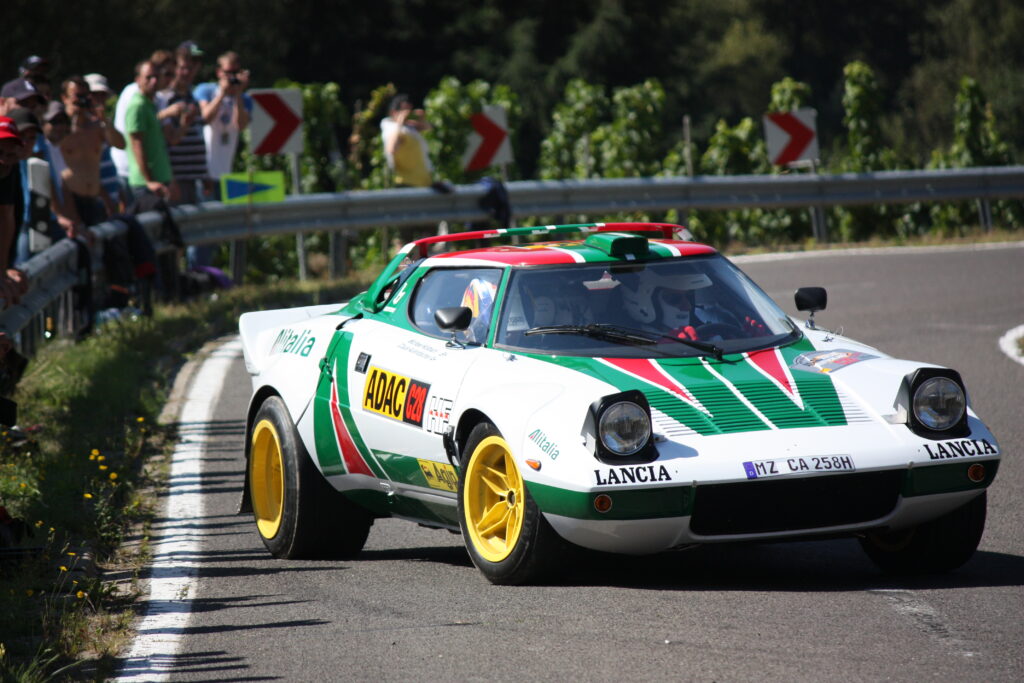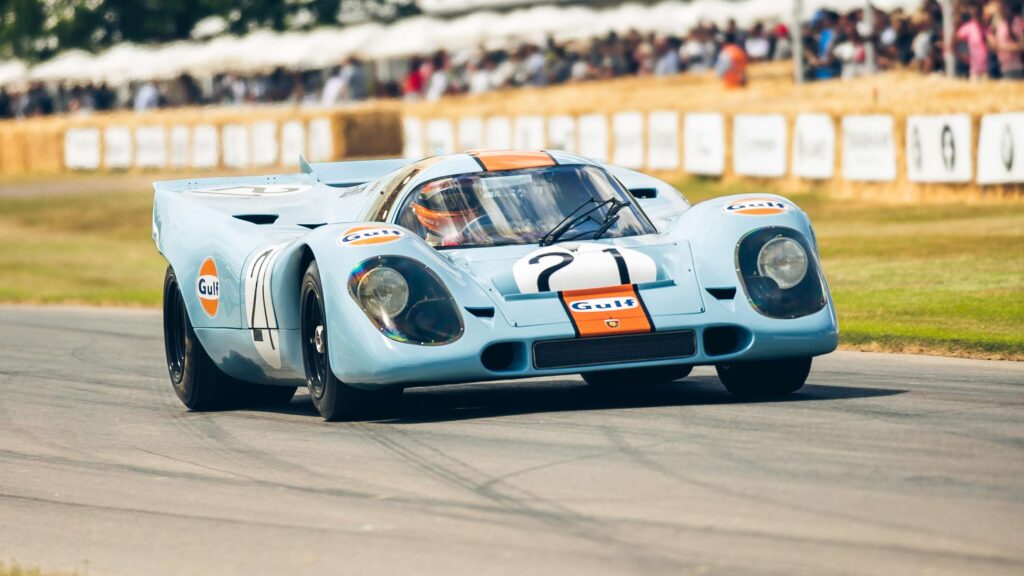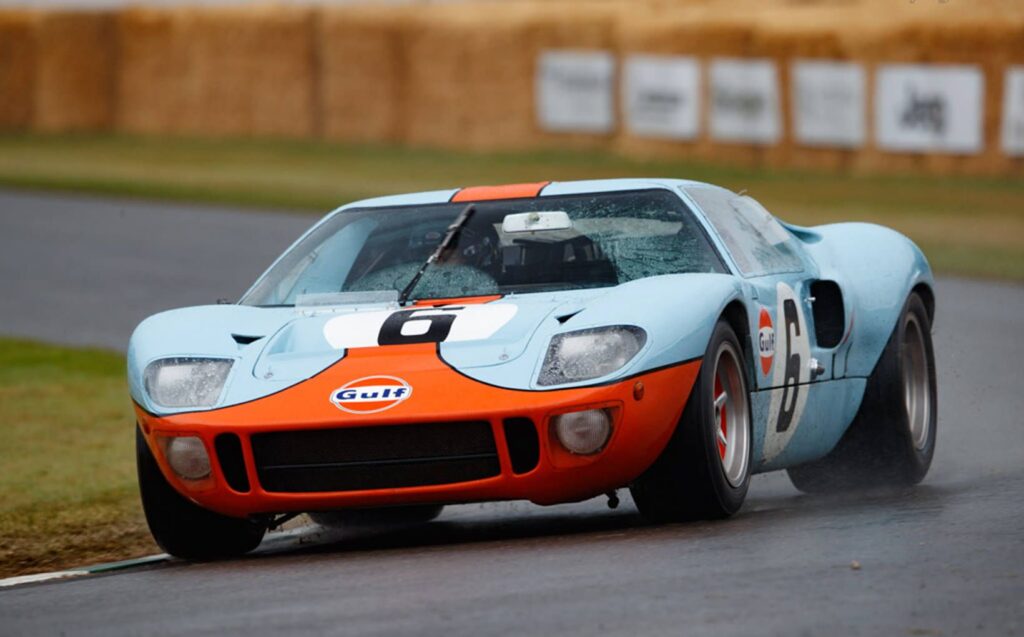Sports racing cars have captured the imagination of racing fans for decades, the epitome of speed and power. They are the result of cutting-edge technology, expert engineering, and an unrelenting pursuit of performance.
From their sleek designs to the ear-splitting roar of their engines, iconic sports racing cars embody the thrill of high-speed competition.
In this article, we take a look back at seven of the most iconic sports racing cars of all time. These vehicles have made a lasting impact on the world of motorsports, leaving their mark on the racetrack and in the hearts of racing enthusiasts everywhere.
So, buckle up, and get ready to relive some of the greatest vehicles in sports racing history.
Lancia Stratos

Introducing the Lancia Stratos: the car that redefined what a rally car could be.
In the 1970s, Lancia set out to create a vehicle that would dominate the rally scene, and they succeeded with the Stratos. This sleek, wedge-shaped vehicle was designed by Marcello Gandini, the head designer at Bertone, and was powered by a 2.4-liter V6 engine sourced from Ferrari.
With a total of 492 units built between 1973 and 1978, the Stratos quickly established itself as a force to be reckoned with on the rally circuit.
Not only did the Stratos have a unique and striking design, but it also had the power to back it up. The road-going version of the car had a top speed of 230km/h, while the rally version was even faster thanks to a more powerful 24-valve engine. The Stratos was also incredibly lightweight, coming out at just under a tonne, making it a nimble and agile car on the track.
The Stratos was a dominant force in the rally circuit, clinching the World Rally Championship title for three consecutive years from 1974 to 1976 and continuing to perform well into the 1980s.
Despite attempts to limit its competitiveness, the Stratos remained a formidable car for years. The Stratos was so dominant Lancia even attempted to modify two versions of the car for endurance racing, adding a large turbo to the engine and fitting massive wings.
Top of our list, the Lancia Stratos is a legendary car in the automotive industry and a shining example of innovation and design. With its bold appearance, high-performance engine, and remarkable track record, the Stratos set a benchmark for future rally vehicles.
Whether you're a car enthusiast or simply appreciate unique vehicles, the Lancia Stratos is worth a look.
The Stratos takes its place amongst the legends on our Rally Legends – The Trackmasters poster.
Porsche 917

Get ready to relive the glory days of one of the greatest race cars ever made: the Porsche 917. This iconic vehicle embodies ambition and top-notch engineering. Even after 50 years, the Porsche 917 continues to be a legend in the world of sportscars, associated in the minds of motorsports enthusiasts everywhere with thrilling victories and impressive engineering.
In 1967, the Porsche Motorsport team returned from Le Mans with a 5th place finish with the 907 and a class victory, but they weren't satisfied. A victory at the 24 Hours of Le Mans was the only goal that mattered.
It was a bold goal for a small sports car manufacturer like Porsche, but a team led by Hans Mezger, Peter Falk, and Helmut Flegl embarked on a mission to quickly develop a competitive sports car and just two years later, in April 1969, the team presented 25 models of the Porsche 917 to the FIA for approval.
Despite a mixed first season, the 917 shone at the 1970 24 Hours of Le Mans, securing first and second place. The Porsche 908 placed third overall, making it a complete triumph for Porsche. The rest, as they say, is history.
The Porsche 917 went on to repeat its victory at Le Mans the following year also conquering the North American CanAm racing series. Following this success, the car continued to evolve and as the 917/30 it even became the most powerful Porsche race car of all time.
But despite its historic run of success, rule changes in a range of racing series made the participation of the 917 impossible leading to its retirement, the Porsche 917 left behind a legacy of 19 overall victories at Le Mans and the development of high-performance turbo engines that found their way into the 911 series.
White The Porsche 917 may have had a relatively short run, long term it set the standard for Porsche's future.
Enjoy its style in prototype blue with our classic print.
McLaren F1

Get ready for the ride of your life with the McLaren F1, the ultimate supercar designed and manufactured by the elite team behind the successful Formula 1 team, McLaren Automotive.
The F1 was revolutionary, with a cost-no-object approach to building a car that changed the way we think about supercars forever. The F1 was a clean-sheet design with all components designed built specifically for it, with an emphasis on efficiency and weight reduction.
The car was made of featherweight carbon fibre and every mechanical component was made of aluminium or magnesium, even the Kenwood stereo, air conditioning and gold-plated titanium tools were designed to specific weight specifications.
The F1 was not just a pretty face, it had a great racing history, with the 220-mph GTR competition version taking first, third, fourth, and fifth overall against a slew of purpose-built racers, blowing the competition away.
The F1 is still considered one of the fastest cars ever built and is a must-have for any car enthusiast's collection. It's performance pedigree backs up its heavy price tag and is currently the most expensive modern supercar in the used market.
Audi Quattro

Introducing the Audi Quattro: the car that revolutionized the rally scene.
The Quattro was first introduced in 1980 and remained in production until 1991, with a total of 11,500 units built. What sets the Quattro apart from other rally cars was its use of four-wheel drive technology. This new technology allowed the Quattro to dominate rallies across the globe against its two-wheel-drive opponents.
The initial idea for the Quattro came from an Audi engineer who noticed that a slow and lumbering VW Iltis jeep with four-wheel drive was far better at driving in the snow than any other car. This sparked the development of a 4WD prototype based on the Audi 80 saloon, which eventually led to the birth of the Quattro. The Quattro featured a 197bhp five-cylinder turbocharged engine and flared wheel arches, which set it apart from the standard Audi Coupe on which it was based.
It only made sense to take the Quattro racing, and it soon came to dominate rallies across the globe. The Quattro won the World Rally Championship on two occasions, first in 1982 driven by Michèle Mouton and then two years later in 1984 with Stig Blomqvist.
The Quattro took 23 rally victories between 1981-1985, however, it’s days at the top were numbered and towards the back end of the 80’s the Quattro was getting outgunned by faster cars like the Lancia Delta S4 and Peugeot 205 T16.
As a result, Audi attempted to reinvent the Quattro for the Group B era, with the short-wheelbase Sport Quattro and the Quattro S1 E2, but it was too late to give the Quattro to hold out against its rivals. When Group B machines were banned in 1986 Audi ended an era and announced they would no longer take part in front-line WRC events, bringing the age of the Quattro to an end.
Despite its retirement, the Quattro's reputation had been established, and it is now considered a bona-fide classic with auction values which reflect its cult status amongst motorsport enthusiasts. The team behind the Quattro also went on to establish Audi's performance car division, and the quattro tag is used to this day on any four-wheel-drive Audi.
The spirit of the Quattro lives on in models like the Coupe S2, RS2 Avant and more recent Audi TT RS and RS3 Sportback and its legacy will forever be a part of automotive history.
Celebrate its history with our Sport Quattro Poster.
Ford GT40

The Ford GT40 was a revolutionary car built to take on the dominant Ferrari at the Le Mans 24 Hours race.
Relive the drama of this epic battle with the Ford Vs Ferrari print.
Developed by Ford's Advanced Vehicles division, the GT40 was built to be fast and efficient, with a 4.2-liter Ford Fairlane engine that was upgraded to the lighter and more powerful 350bhp "Indianapolis" version from the Lotus 29.
The suspension was also fine-tuned with double wishbones at the front, transverse links and radius arms at the rear, and wind tunnel testing was used to improve the aerodynamics of the car.
The GT40 was designed to reach speeds of up to 125mph and was made of fibreglass for better durability and less weight.
Despite early setbacks, accidents and failures, the Ford GT40 ultimately proved to be a game-changer in the world of motorsports, winning the Le Mans race in 1966, 1967, 1968 and 1969 and ending Ferrari's dominance in the event.
The Ford GT40 was the result of a dedicated team of engineers, designers and race managers who worked tirelessly to create a car that could stand up to the competition and made Ford a household name in the world of motorsports.















